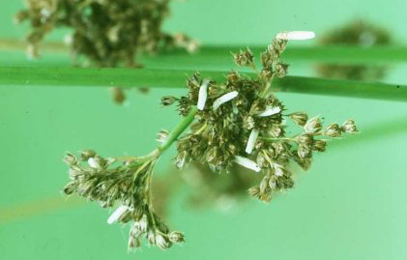|
||||||
|
Coleophora
alticolella Zeller, 1849 Common Rush Case-bearer Coleophora alticolella Zeller, 1849. Linn. ent. 4: 341. |
||||||||||||||||||||||||||||||||||||||||||||||||||||||||||||||||||
Seed-feeder and case-bearer: Larva feeds on seeds. The full-grown case is 6 mm long, and not separable from those of Coleophora glaucicolella (British leafminers).
Larva: The larvae of moths have a head capsule and chewing mouthparts with opposable mandibles (see video of a gracillarid larva feeding), six thoracic legs and abdominal legs (see examples). Pupa: The pupae of moths have visible head appendages, wings and legs which lie in sheaths (see examples). Adult: The adult is illustrated in UKMoths (by Rob Edmunds) and the Encyclopedia of Life. The species is included in mothdissection.co.uk. Hosts in Great Britain and Ireland:
Hosts elsewhere:
Time of year - larvae: August to October, some larvae feeding again in the spring (British leafminers). Time of year - adults: June and July, possibly late April and May, at sunrise, dusk and night (UKMoths). Distribution in Great Britain and Ireland: The most widespread and common British Coleophora species, occurring wherever the appropriate rush species grow and seed, up to 660 metres above sea level in some years (UKMoths), including Anglesey, Ayrshire, Banffshire, Bedfordshire, Breconshire, Buckinghamshire, Caernarvonshire, Cambridgeshire, Carmarthenshire, Cheshire, Cumberland, Denbighshire, Dorset, Dumfriesshire, Dunbartonshire, Durham, East Cornwall, East Gloucestershire, East Kent, East Norfolk, East Ross, East Suffolk, East Sutherland, Easterness, Fife, Flintshire, Glamorgan, Haddington, Herefordshire, Hertfordshire, Huntingdonshire, Isle of Wight, Kincardineshire, Kirkudbrightshire, Leicestershire, Main Argyll, Merionethshire, Middlesex, Montgomeryshire, North Aberdeenshire, North Ebudes, North Essex, North Hampshire, North Lincolnshire, North Somerset, Orkney, Outer Hebrides, Pembrokeshire, Shropshire, South Aberdeenshire, South Devon, South Hampshire, South Lancashire, South Northumberland, South Somerset, South Wiltshire, South-east Yorkshire, South-west Yorkshire, Stafford, Stirlingshire, Surrey, West Cornwall, West Gloucestershire, West Lancashire, West Norfolk, West Perthshire, West Ross, West Suffolk, West Sussex, West Sutherland, Westerness, Westmorland, Wigtownshire, Worcestershire and Shetland (NBN Atlas), and the Channel Is. (Fauna Europaea). Also recorded in the Republic of Ireland and Northern Ireland (Fauna Europaea and National Biodiversity Data Centre Map). Distribution elsewhere: Widespread in continental Europe including Austria, Belgium, Bulgaria, Crete, Croatia, Czech Republic, Danish mainland, Estonia, Finland, French mainland, Germany, Greek mainland, Hungary, Iceland, Italian mainland, Latvia, Liechtenstein, Lithuania, Luxembourg, Norwegian mainland, Poland, Romania, Russia - Central and South, Sardinia, Slovakia, Slovenia, Spanish mainland, Sweden, Switzerland, The Netherlands and Ukraine (Fauna Europaea). NBN Atlas links to known host species:
British and Irish Parasitoids in Britain and elsewhere:
|
||||||||||||||||||||||||||||||||||||||||||||||||||||||||||||||||||
|
|
|
| External links: | Search the internet: |
Belgian Lepidoptera |
Find
using Google
Find using Google Scholar Find images using Google |
| Last updated 11-Jul-2019 Brian Pitkin | ||

